Introduction
Ornamental fishes attract and fascinate people of all ages, making aquarium keeping one of the most popular hobbies around the world. In the aquarium hobby, ornamental fish are all about color! Goldfish (Carassius auratus) were bred for color in China over a thousand years ago. Likewise, the common carp (Cyprinus carpio) was selectively bred in China, and beginning in the 1800s, popularized in Japan as "koi" for their colorful varieties and patterns, and for all the extreme body shapes and sizes shown within varieties. "Koi," or "goi," meaning carp, is short form of "nishiki-goi" or "embossed carp fish" in reference to the art of "nishiki," to brocade fabric; "koi" also symbolizes tender passion and love in Japan. Of course, ornamental fishes are also sought for the aquarium because there is a vast array of species and varieties available in the market (more than any other pet or companion animal). Aquarists enjoy displaying the numerous species with their intricate behavioral patterns and trying to replicate the unique natural habitats in which the fish live.
Fishes exhibit an array of beautiful colors, like those of the rainbow, from light violet to indigo and deep blue; many tints and shades of green; bright, light, and dark yellows and oranges; and vibrant red hues. They also display all the colors from the "line of purples," which are the shades of color between blue and red, like purple, magenta, and rose colors. As one might expect, the arrays of vibrant colors that adorn fish bodies appropriately give rise to the word "ornamental" fishes and their descriptive names (e.g., purple tang, magenta dottyback, blue chromis, blue discus, yellowtail blue damselfish, electric yellow cichlid, flame angelfish, psychedelic, and mandarin fish).
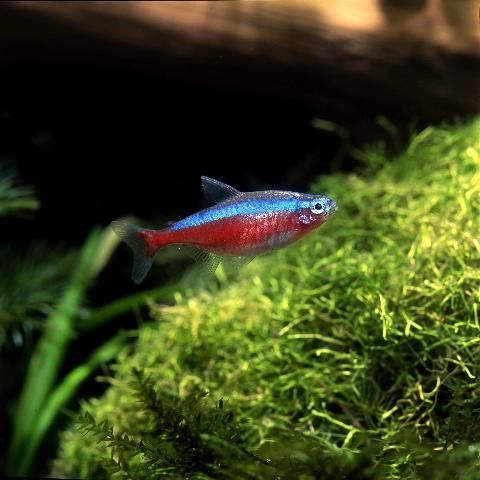
Credit: Harry J. Grier
Although color in the skin of fishes is principally genetically determined, what is not often recognized but necessary for maximum color development is that fishes are unable to produce color pigments of certain types of red, orange, yellow, green, and even some blues, which all must be obtained from the food they eat. Therefore ultimate color expression of individuals is closely related to the fish's diet and the pigment content of their food. Fishes raised in aquariums or intensively in recirculating water systems without pigment supplementation in their diet will lose their vibrant hues, and colors will fade. Even when ornamental fishes are raised in ponds, dietary pigment supplementation is beneficial because their color, as in their wild counterparts, will be more variable. This publication addresses how ornamental fishes attain their colors and provides a list of ingredient sources for pigments that can be used to enhance and intensify coloration in fishes through their diet.
Colorants
Pigments and dyes are examples of colorants, compounds that impart colors to other materials. The color and shade imparted to the material are determined by the properties of the particular colorant, by selective absorption of light, and also by the scattering effects of the material. The colorant material itself may be completely colorless but can vary the light transmission and reflection properties in the object.
There are thousands of different kinds of pigments and dyes that can be broadly classified as being of three kinds: 1) biological pigments formed and found in living tissue; including those extracted directly from animal, plant, or root sources; 2) mineral (earth) origin pigments; and 3) synthetic pigments that are manufactured. In the color industry pigments usually consist of insoluble particles. The dry pigment is simply mixed into water, oil, or another type of solvent and used for coloring paints, inks, plastics, and cosmetics. Dyes depend on chemical and physical reactions to impart their color and are usually water-soluble and in liquid form. Dyes are typically used for coloring paper, fabrics, textiles, and similar materials. Vital dyes are used to stain tissues and cells to easily identify them and allow evaluation microscopically.
Fishes can only absorb, metabolize, and deposit in their body (e.g., skin, flesh) pigments of biological origin. They cannot utilize pigments of mineral origin, paints or dyes, and deposit them as functional colorants in their skin. Some unscrupulous dealers paint or dye ornamental fish with bright colors and sell them. The colorant is commonly applied by direct injection or by dipping the fish in the dye solution. Regardless of the method used, the colors applied in this manner will eventually fade because the fish cannot properly use or deposit these paints or dyes.

Credit: UF/IFAS
The Chromatophores and the Color Pigments in Fishes
Only biological pigments, or biochromes as they are also often called, can give ornamental fishes their brilliant hues. These biological pigments or biochromes are contained within specialized skin cells called chromatophores. Chromatophores have different names depending on the principal type of pigment they contain or the color they reflect. At least six types of chromatophores have been described in fishes: melanophore cells are black or brown; cyanophores are blue; xanthophores are yellow to burnt yellow (ocher); erythrophores contain reddish pigments; leucophores are white; and the iridophores (or guanophores) that contain guanine reflect iridescent colors and metallic hues. Actually, the shape of the organelle containing the pigment in chromatophore cells corresponds to different colors; thus fossilized pigment organelles can help scientists identify the color of ancient animals in their fossil records (e.g., in birds and dinosaurs).
Different Kinds of Pigments
Melanin is the primary pigment in animals, while chlorophylls and carotenoids are the primary pigments in plants. Melanin is a generic term for several insoluble pigments that are formed from the buildup and break down of proteins in the cell. Melanin-containing cells are called melanophores. Melanin is responsible for most of the dark colors (browns, yellow, dark gray, and black tones) in animal skin, hair, fur, and feathers. Chlorophyll imparts the green color to cyanobacteria (blue-green algae), algae, and plants.
Colors like blue, green, yellow, orange, and red are derived mostly from carotenoids; of which, some 600 have been described.
Carotenoids can be organized according to their chemical structure into two major groups, the carotenes and the xanthophylls. The carotenes have a chemical structure of hydrocarbon molecules that contain no oxygen. In contrast, the xanthophylls are oxygen rich. Whether carotenoids contain oxygen in their molecules influences their ability to provide pigment and offer other valuable attributes. For example, the lack of oxygen renders carotenes chemically hydrophobic and insoluble in water; therefore, making them powerful antioxidants.
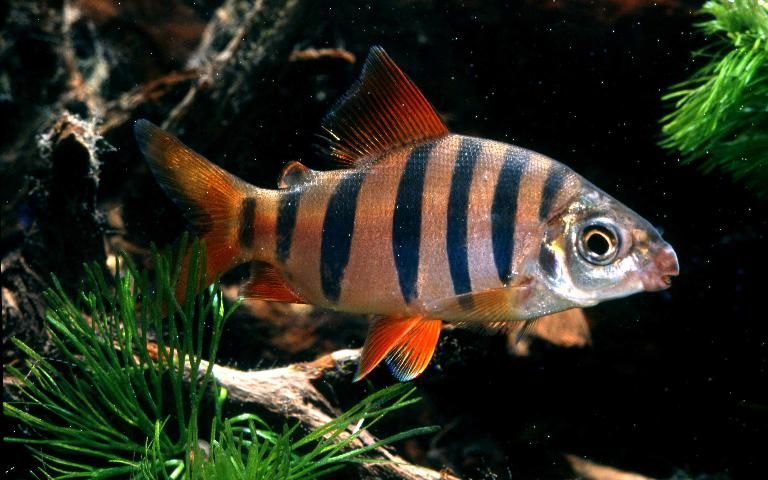
Credit: Harry J. Grier
The carotenes provide the deep oranges and red hues to the skin of many animals and plants; carotenes are responsible for the orange color in carrots, hence their name. In nature, the carotenes astaxanthin and canthaxanthin are the most abundant carotenoid pigments found in aquatic animals. They are responsible for the predominant red pigmentation in finfish and shellfish such as trout, salmon, ornamental fishes, lobsters, and shrimps. Also, during cellular metabolism in some fishes and other aquatic organisms, many of the carotenoid pigments, especially astaxanthins, are combined with specific proteins and lipids in the cell, creating beautiful blue, green, and purple colors. Astaxanthin not only serves as an efficient source of pigment but is also recognized as one of the most potent antioxidants in nature. Astaxanthin protects against light (photoxidation) and other detrimental oxidation reactions in fish and crustaceans. The immune systems of fish and other animals are also enhanced by the presence of astaxanthin.
Xanthophylls like lutein and zeaxanthin are primarily yellow pigments found in the leaves of most plants. Lutein produces a yellow color, whereas zeaxanthin imparts a more intense yellow-orange color.
Carotenoid Availability
Because of their chemical makeup, the major carotene and xanthophyll pigments can only be synthesized by photosynthetic organisms like algae and plants, some bacteria, fungi, and a few plant-eating insects. In the wild, fish obtain most of their color pigments by eating primarily planktonic copepod crustaceans (microscopic zooplanktonic animals drifting and swimming in the water column). These zooplanktonic animals, too, must obtain their pigments from microscopic algae and plants (phytoplankton). In other words, most animals, including fishes, reptiles, amphibians, and birds, cannot synthesize their own carotenoid pigments and must obtain them through the food they eat. Once consumed, carotenoid pigments can be deposited directly within chromatophore cells or converted by cellular metabolism into other compounds that can impart an array of colors to the skin, meat, feathers, or other tissues.
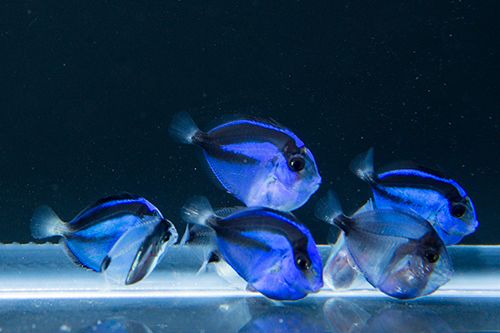
Credit: UF/IFAS
The Skin of Fishes
The skin of fishes is thick or thin depending on the species, but, for many species, consists of scales, scutes (or plates), and three layers of live tissue: the epidermis, which is the outermost layer, a middle dermis layer, and the innermost subcutaneous tissue layer. The skin in some species consists only of these three layers with no scales, scutes or plates.In most fish, the scales and skin are covered by a protective outer layer of mucous. The mucus and specialized toxic (poisonous) and alarm compounds that protect the fish or serve as reliable signals of predatory risk are produced and secreted by cells located within the epidermal layer. The epidermis may also contain disease-protective antibodies and lysosomes that function in producing digestive enzymes capable of breaking down most living matter, especially infectious bacteria. However, the scales or scutes are formed and embedded in the dermis, and, as they grow and protrude out of the skin, they are covered by a very thin layer of epidermis. Therefore, when there is a loss of scales it will most likely damage the skin. During wound healing, epithelial cells of the epidermis multiply rapidly and cover the injured skin. The dermis of the skin in fishes also contains the chromatophores and a fine network of nerves and blood vessels. Also in the dermis are other specialized cells and structures that serve as sensory receptors that respond, for example, to mechanical, chemical, and thermal stimuli. The subcutaneous layer of the skin is formed primarily of loose connective tissue that fasten, the skin to the underlying tissues (e.g., bone, muscle, and the peritoneum that forms the lining of the body cavity), and often contains deposits of fat that may serve as a reservoir of energy.
The Color of the Skin in Fishes
Fish skin color is the result of a combination of genetics, biological pigments, structural color, and what the fish eat (diet). The skin color in fishes is principally genetically determined, and skin color can be inherited from generation to generation. Genes regulate a variety of processes that determine how much of a specific pigment type, like melanin, is produced, and how it is deposited in the chromatophores. Pigment types range from dark to light black, gray, brown, orange, yellow, and red. However, not just one but several genes influence skin color, permitting the environment to have greater control over variation in skin color, and making the process of selective breeding for fish skin color more problematic and slower.
Structural colors are reflective or iridescent colors created by the selective optical transmission (or interference) of light through the multilayered stucture, shape, and arrangment of the scales, or the chromatophores themselves, on a fish. The silver sheen in the scales and eyes of fishes comes from guanine crystals. Guanine is one of the four bases common to DNA and RNA; the others are adenine, cytosine, and thymine. The DNA and RNA molecules are responsible for carrying the genetic information for inheritance. Like melanin, guanine crystals are also formed from the metabolism of proteins. The crystals are deposited in the skin just beneath the scales, in the skin closest to the adjacent muscle. The crystals appear as thin plates and stack into layers as they buildup onto the scale. The stacked layers interfere with the light, changing its color and producing the shine or silver-iridescence. The shiny and pearly-white substance known as "oriental or pearl essence" in fish scales is also made from guanine crystals. Since the seventeenth century, pearl essence was the secret main ingredient used to imitate real pearls. Crystalline guanine, from fish scales, is still used today in skin creams, lotions, eye shadow, lipstick, nail polish, shampoos, and other cosmetics to provide them with shimmering luster, and a pearly iridescent effect.
Dietary sources of biological pigments also play an essential role in determining skin color. In most ornamental fishes, color is largely influenced by particular biological pigments that can only be obtained from the foodstuffs they eat. The optimum coloration can only be achieved by regular intake of the right amount of the right type of pigment. The pigment type must also easily be absorbed and utilized by the body.
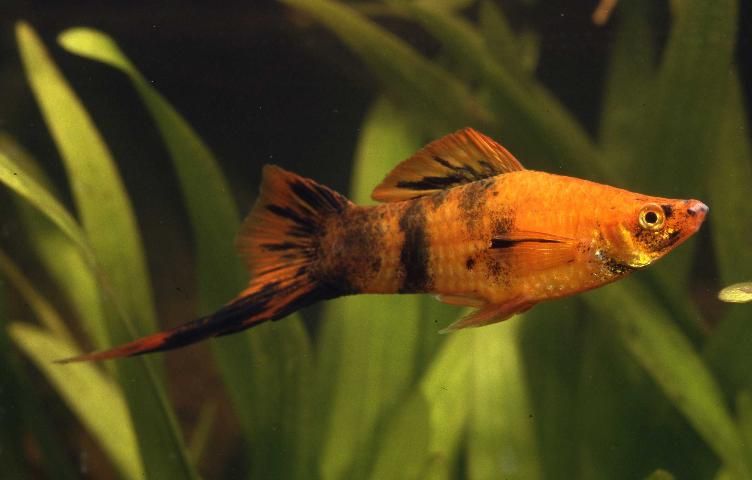
Credit: Harry J. Grier
How Color Is Displayed
The skin in ornamental and other fishes is usually white, but also in many is almost transparent or colorless. The light reflection and refraction caused by the shape, structure, and placement of the chromatophores will impart the actual color. The overlaying and arrangement of the different types of chromatophores creates the skin color we perceive. The iridescent shine and shimmer of the scales will adorn the fish and enhance or subdue the coloration of the chromatophores. For example, the guanine in the iridiophores reflects iridescent colors and metallic hues, but blue waves are reflected more, giving the skin a blue color. And most green colors are created by the reflection of the blue light coming through an over-layer of yellow pigments.
The fish can control its color expression through the nervous and hormonal system. In response to environmental cues (e.g., light and temperature), the fish's brain can directly control the chromatophores. For example, the chromatophores can concentrate the pigment granules to the center of the cell to make the skin become lighter, or the pigments be dispersed, hence darkening the skin.
Fishes also can rapidly change color in many types of social interactions, including reproduction. A fish's species and gender can be identified by its color, and color can signal to a mate a readiness to breed. Color serves to camouflage or blend with the environment for protection, and avoid or deter potential harm from predators. Color pigments are also essential in biochemical pathways that occur continually in living organisms and are necessary to maintain life.
The natural source of the pigment (plant or animal) also plays a very important role in the outcome of a particular pigmentation or coloration. Plant pigments, especially, will often not have the ability to provide the desired deep orange and red coloration found in the fins, flesh, and skin of many fishes. For instance, salmonids do not have the ability to convert lutein (yellow) and zeaxanthin (red) carotenoids from plants into the brilliant red colors obtained from the pigment astaxanthin alone; the colors obtained from canthaxanthin are also duller than those of astaxanthin. Therefore, a major source of red pigments for the salmonid and other fishes are zooplankton animals that have the ability to convert these into canthaxanthin and astaxanthin.
Dietary Supplementation with Naturally Obtained and Synthetically Made Pigments
Since skin color in ornamental fishes is largely influenced by the quality and quantity of pigment in their diet. Farm producers want reliable pigment sources that provide consistent results and coloration that will not fade away. One reason for the artificial addition of carotenoid pigments to the diet of ornamental fish is to ensure that the pigment is continuously present and the coloration does not fade away. An obvious disadvantage in marketing ornamental fish collected from the wild is that often the quality or quantity of pigments consumed in the wild, especially at different times of the year, is not consistent, and therefore there is a wide variation in their skin tones.
Two of the major carotenoids fed to fishes to enhance their coloration are the red carotene pigments, astaxanthin and canthaxanthin, and the yellow xanthophyll pigments, lutein and zeaxanthin. Because red, green, blue, and yellow can be obtained from these two carotenoid groups, incorporation of them into diets can impart a wide spectrum of colors to the fish. Fishes can efficiently use the pigments from both these sources; however not all of them may be able to absorb them the same way. For example, salmonids absorb canthaxanthin and astaxanthin up to 20 times more efficiently than lutein and zeaxanthin, whereas channel catfish absorb lutein and zeaxanthin more efficiently than astaxanthin. In ornamental fishes, the most desirable red hues are obtained with astaxanthin extracts; however, goldfish cannot easily convert beta-carotene into a red coloration. In multicolor fishes, a combination of carotenoid and xanthophyll pigments produces the best coloration. We have also observed that certain pigment types are absorbed better than others depending on the kinds of ingredients used to prepare the feed the particular pigment is added to. Absorption may perhaps be related to the acid-base balance of the feed. (Achieving optimal acid-base balance in feed generally leads to improved pigment utilization in certain avian species.)
Both carotene and xanthophyll pigments are available from natural sources and also produced synthetically. Sources of natural ingredients are available in powder or oil form. A summary of several ingredients rich in astaxanthin and xanthophyll is presented in Table 1. However, only a few commercial chemical companies such as BASF Corporation and DSM Nutritional Products manufacture these pigments in large commercial quantities. Many people are concerned about the pigments produced by industrial synthesis, but over time these synthetic pigments have developed an excellent reputation for efficacy and safety and have been approved by the US Food and Drug Administration for use in foods, drugs, and cosmetics (see FDA Summary of Color Additives and Code of Federal Regulations, e.g., CFR 73.35 Astaxanthin and CFR 73.75 Canthaxanthin).
Many farmers and aquarists prefer to use pigments directly obtained from nature, such as from microalgae (e.g., Haematococcus pluvialis), shrimps, krill, and extracts of marigold flowers. The carotenoid pigments are found in the greatest amount in the oil extracts of animal and plant ingredients. However, these pigments are sensitive to quick degradation, especially by heat and oxygen; therefore, the processing and extraction process may alter the amount and bioavailability of the obtained pigment. Pigment yields and their bioavailability are the highest when they are captured in their native form (a chemical carotenoprotein complex). This is best accomplished by extracting the oil by simple maceration and pressing at low temperatures. Also, pigment extracts are easily obtained from algae themselves and shellfish wastes when sun-dried or vacuumed at low temperatures. Pigments in oils extracted from fermentation of shellfish wastes also appear to increase their yield and bioavailability. Lowest pigment concentrations are obtained from unprocessed shellfish.
Most fish farmers and hobbyists buy their feed from commercial feed manufacturers that have the pigments already incorporated. If desired, pigments can also easily be added to commercial feed formulations for fish destined for food consumption that usually do not have pigments added. Also, small quantities of pigmented feeds are often needed, for example, for feeding difficult-to-maintain aquarium fishes, larval fishes, or small juveniles, and simply for experimental purposes. Most fish hobbyists buy the bulk of their feed from commercial manufacturers, but many also prepare home-made-feeds. Pigments are added into the diet at varying concentrations depending on whether or not they are of natural or synthetic origin. Typically, dietary carotenoid concentrations have varied from 60 mg/kg to 700 mg/kg of dry feed. For example, the most desirable red hues are obtained with astaxanthin extracts in most of the species tested. In multicolor fishes, a combination of carotenoid and xanthophyll pigments will produce the best coloration. There are numerous natural sources of pigments that can be used to impart color to the skin of ornamental fishes. A summary of several ingredients rich in concentrations of astaxanthin and xanthophyll is presented in Table 1.
Although the nature of coloration and pigmentation in ornamental fishes remains poorly investigated, it has been shown that feeding the desired pigment at the right concentration will enhance fish coloration and produce fish of an ornamental quality that will equal or exceed the quality of fish coming from the wild.
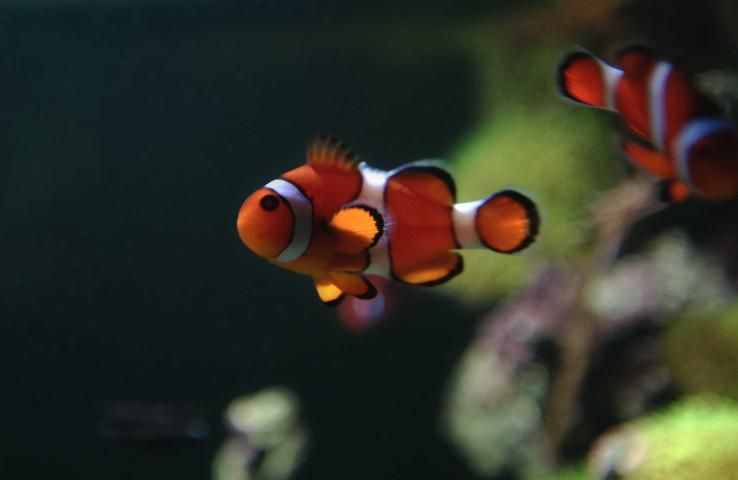
Credit: UF/IFAS
Bibliography
Lovell, T. 1992. "Dietary enhancement of color in ornamental fish." Aquaculture Magazine, September/October 77–79.
Royes, J. B. and F. Chapman. 2003. Preparing your own fish feeds. CIR97. Gainesville: University of Florida Institute of Food and Agricultural Sciences. https://edis.ifas.ufl.edu/fa097
Torrissen, O. J., R. W. Hardy, and K. D. Shearer. 1989. "Pigmentation of salmonids—carotenoid deposition and metabolism." CRC Critical Reviews in Aquatic Sciences 1: 209–225.
Wallat, G. K., A. M. Lazur, and F. Chapman. A. 2005. "Carotenoids of different types and concentrations in commercial formulated fish diets affect color and its development in the skin of the red oranda variety of goldfish." North American Journal of Aquaculture 67: 42–51.